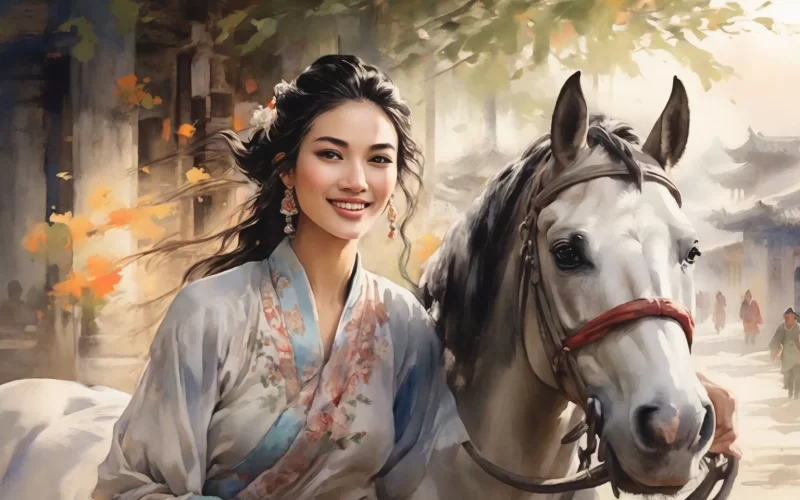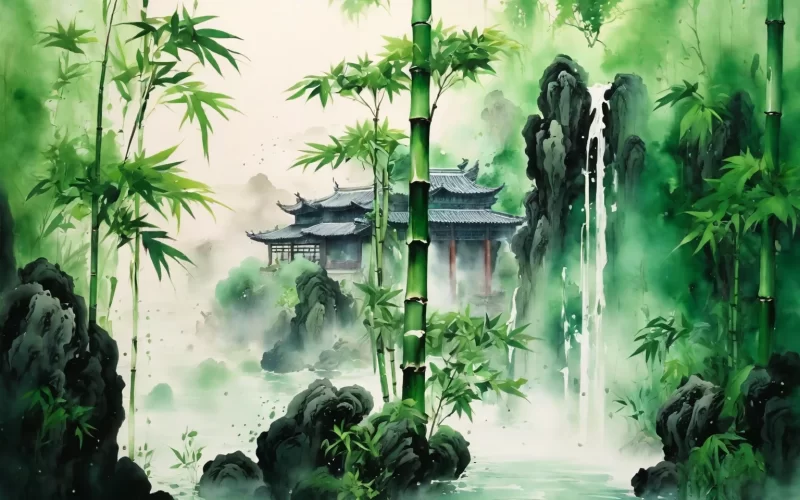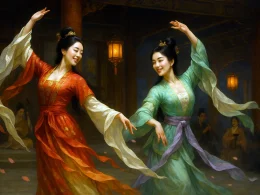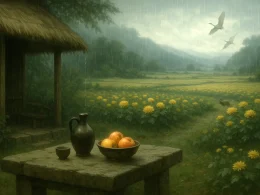My prancing steed, a骄 shadow on the blossom-strewn lane,
My hanging crop, a chance, flicks her carriage, a chariot of painted light.
The lady fair, with a smile, draws aside her pearl-strung screen,
And points to a vision afar: “Behold, my home, the tower of crimson, burning bright.”
Original Poem
「陌上赠美人」
李白
骏马骄行踏落花,垂鞭直拂五云车。
美人一笑褰珠箔,遥指红楼是妾家。
Interpretation
Composed during Li Bai's wandering years, this poem vividly captures a quintessential romantic moment in Tang capital life. It portrays neither palace-bound women nor rustic maidens, but a bold yet elegant encounter between aristocratic youths on the streets of Chang'an or Luoyang, brimming with the confidence, openness, and youthful energy characteristic of the High Tang era. The "Five Mausoleums" refer to imperial tomb areas near Chang'an where wealthy young nobles resided, indulging in leisurely pleasures. With lively fluency, Li Bai depicts a romantic meeting that showcases the gallant demeanor and unrestrained love ethos of Tang youth. Through imagery of steeds, beauties, and vermilion towers, the poem creates a dynamic, theatrical scene immersing readers in youthful passion.
First Couplet: "骏马骄行踏落花,垂鞭直拂五云车。"
Jùn mǎ jiāo xíng tà luòhuā, chuí biān zhí fú wǔ yún chē.
My proud steed treads fallen blooms in stride; My hanging whip brushes your cloud-carriage side.
From the male perspective, this couplet crafts a dashing "Five Mausoleums youth" in fourteen characters. "Proud steed in stride" displays status and demeanor; "treads fallen blooms" specifies season (late spring) and scenic beauty. "Hanging whip brushes" is inspired—this seemingly accidental yet intentional gesture serves as both exploration and approach, full of playful flirtation, foreshadowing subsequent developments.
Second Couplet: "美人一笑褰珠箔,遥指红楼是妾家。"
Měirén yīxiào qiān zhū bó, yáo zhǐ hónglóu shì qiè jiā.
The beauty smiles, lifts her beaded screen; Points to a distant tower: "There my home lies unseen."
Shifting to the female response, her composure and boldness complement the male's free-spirited elegance. "Smiles, lifts her beaded screen" captures the woman's grace and intelligent understanding—she recognizes his intent and responds actively. "Points to a distant tower" is the poem's climax, speaking volumes without words. This gesture reveals identity, hints at invitation, and showcases High Tang women's rare initiative in specific contexts, elevating a street encounter into romantic drama full of possibility.
Holistic Appreciation
The poem's charm lies in its theatricality and perfect ambiguity. It captures love's most suggestive moment—the beginning—like a micro-film's opening: a handsome hero (gallant steed-rider), a beautiful heroine (behind beaded screen), a meaningful meeting (whip brushing carriage), and an evocative conclusion (pointing to tower). The poet uses cinematic language: first a dashing close-up of the male, then cutting to the female's charming response, finally freezing on the symbolic "vermilion tower" vista. The story ends abruptly, leaving all imagination to readers. This incompleteness grants the encounter eternal artistic charm, perfectly demonstrating "words end but meaning continues."
Artistic Merits
- Narrative Through Action: A series of precise actions ("treads," "brushes," "smiles," "lifts," "points") advance plot, shape characters, and convey emotion, achieving "implying depth without explicit words."
- Symbolic Imagery: "Steed" and "cloud-carriage" reflect noble status; "fallen blooms" indicate season and romantic atmosphere; "vermilion tower" symbolizes wealth and tenderness—together building a gorgeous poetic world.
- Natural Perspective Shift: The first two lines from the male view seamlessly transition to the female perspective in the latter two, presenting complete interaction for three-dimensional imagery and plot.
- Aristocratic Elegance Meets Folk Freshness: The subject and characters bear distinct noble tones, while the brisk rhythm, vivid plot, and subtle expression absorb the freshness of Southern Dynasties folk songs.
Insights
This poem presents a healthy, bright model of gender relations: mutual attraction based on equality and respect, expressed with intelligent boldness and charm. The male's elegance without frivolity and the female's response—graceful yet reserved—reflect the demeanor expected in highly civilized social interaction. It enlightens us that genuine emotional sparks often stem from courageous yet elegant attempts and mutually understanding responses that respect the other's intent. In contemporary society, this art of interaction—beginning with grace and converging in respect—remains a beautiful realm worthy of appreciation and pursuit.
About the poet

Li Bai (李白), 701 - 762 A.D., whose ancestral home was in Gansu, was preceded by Li Guang, a general of the Han Dynasty. Tang poetry is one of the brightest constellations in the history of Chinese literature, and one of the brightest stars is Li Bai.












